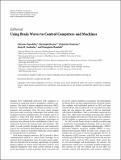| dc.contributor.author | Papadelis, Christos | |
| dc.contributor.author | Braun, Christoph | |
| dc.contributor.author | Pantazis, Dimitrios | |
| dc.contributor.author | Soekadar, Surjo R. | |
| dc.contributor.author | Bamidis, Panagiotis | |
| dc.date.accessioned | 2015-03-20T16:50:26Z | |
| dc.date.available | 2015-03-20T16:50:26Z | |
| dc.date.issued | 2013 | |
| dc.date.submitted | 2013-05 | |
| dc.identifier.issn | 1687-5893 | |
| dc.identifier.issn | 1687-5907 | |
| dc.identifier.uri | http://hdl.handle.net/1721.1/96129 | |
| dc.description.abstract | Humans have traditionally interacted with computers or machines by using their hands to manipulate computer components. This kind of human-computer interaction (HCI), however, considerably limits the human’s freedom to communicate with machines. Over the years, many attempts have been made to develop technologies that include other modalities used for communication, for example, speech or gestures, to make HCI more intuitive. Recent advances in cognitive neuroscience and neuroimaging technologies in particular have allowed for the establishment of direct communication between the human brain and machines. This ability is made possible through invasive and noninvasive sensors that can monitor physiological processes reflected in brain waves, which are translated online into control signals for external devices or machines. | en_US |
| dc.publisher | Hindawi Publishing Corporation | en_US |
| dc.relation.isversionof | http://dx.doi.org/10.1155/2013/802063 | en_US |
| dc.rights | Creative Commons Attribution | en_US |
| dc.rights.uri | http://creativecommons.org/licenses/by/2.0 | en_US |
| dc.source | Hindawi Publishing Corporation | en_US |
| dc.title | Using Brain Waves to Control Computers and Machines | en_US |
| dc.type | Article | en_US |
| dc.identifier.citation | Papadelis, Christos, Christoph Braun, Dimitrios Pantazis, Surjo R. Soekadar, and Panagiotis Bamidis. “Using Brain Waves to Control Computers and Machines.” Advances in Human-Computer Interaction 2013 (2013): 1–2. | en_US |
| dc.contributor.department | McGovern Institute for Brain Research at MIT | en_US |
| dc.contributor.department | Martinos Imaging Center (McGovern Institute for Brain Research at MIT) | en_US |
| dc.contributor.mitauthor | Pantazis, Dimitrios | en_US |
| dc.relation.journal | Advances in Human-Computer Interaction | en_US |
| dc.eprint.version | Final published version | en_US |
| dc.type.uri | http://purl.org/eprint/type/JournalArticle | en_US |
| eprint.status | http://purl.org/eprint/status/PeerReviewed | en_US |
| dc.date.updated | 2015-03-19T11:34:58Z | |
| dc.language.rfc3066 | en | |
| dc.rights.holder | Copyright © 2013 Christos Papadelis et al. This is an open access article distributed under the Creative Commons Attribution License, which permits unrestricted use, distribution, and reproduction in any medium, provided the original work is properly cited. | |
| dspace.orderedauthors | Papadelis, Christos; Braun, Christoph; Pantazis, Dimitrios; Soekadar, Surjo R.; Bamidis, Panagiotis | en_US |
| mit.license | PUBLISHER_CC | en_US |
| mit.metadata.status | Complete | |
